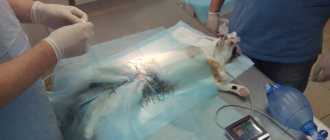Why sterilize your pets?
The sole purpose of this operation is to deprive the animal of the ability to reproduce. In many countries, stray cats and dogs are subjected to this procedure in order to prevent an increase in the number of stray animals inhabiting city streets.
Pets are sterilized to maintain their sexual health (for example, to prevent purulent pyometra) and to prevent the development of cancerous tumors, but most often to eliminate the possibility of reproducing unwanted offspring (if your pet has access to the street where it interacts with other animals).
It is important to remember that estrus is a big stress for a cat, so if you do not plan to breed pets, then you should seriously think about surgery.
Typically, spaying (or neutering) involves the complete removal of the animal's genitals, but sometimes they can be preserved simply by ligating the female's fallopian tubes. In the latter case, fertility is also completely excluded, but the genitals are preserved.
Did you know? In the 20th century, some countries used forced sterilization of people to avoid the growth of a certain nation. This procedure was used in Latin America (sterilization of the poor), Canada (operations on criminals), India and Nazi Germany. Today, human sterilization is strictly prohibited and is identified by the International Criminal Court as a crime against humanity.
Types of cat sterilization
The final result of sterilizing a cat is always the same - within 25-30 days after the procedure, the animal’s hormonal levels decrease and female sex hormones (estrogens) cease to be produced. As a result, the female becomes calm again, she is not tempted to “walk”, she stops worrying and looking for a partner for mating. But there are different types of sterilization - from tubal ligation to complete removal of the uterus and ovaries.
Ligation of oviducts (fallopian tubes)
This operation is called tubal occlusion (tubal ligation). As a rule, this procedure is less painful for the animal and is easier to tolerate by the cat, however, the animal does not get rid of estrus and the need to “walk”. Using an incision on the side, the oviducts are tied, which eliminates the animal’s ability to reproduce.
However, because the uterus and ovaries are not removed, the cat's hormonal levels do not change, and she can still go into heat and be attractive to males. During a very long estrus with ligated fallopian tubes, the cat runs the risk of developing inflammation of the uterus, so sterilization using the tubal occlusion method is rarely used by veterinarians, only according to individual indicators.
Video: types and features of cat sterilization
Ovariectomy (removal of the ovaries)
This is the most popular sterilization option, in which only the ovaries are removed, while the uterus remains intact. Most often used for young or nulliparous cats. As a result of this procedure, the hormonal background of the animal changes, sex hormones are not produced, therefore estrus and all the resulting behavioral characteristics of the cat are excluded.
In addition, ovariectomy is the key to the cat’s health - the risk of ovarian cysts and false pregnancies disappears. However, the procedure itself, like any surgical intervention, is very stressful for the cat and requires a long recovery period.
Among the disadvantages of such an operation is the likelihood of developing inflammatory processes or malignant neoplasms in the uterus, since the organ, in fact, remains non-functioning.
Hysterectomy (removal of the uterus)
Removing only the uterus, while preserving the ovaries, also does not change the cat’s hormonal levels - therefore, the need for communication with cats and mating remains. This method is rarely used in modern veterinary practice, since when the female is in heat, in this case the same problems remain as with tubal occlusion - inflammation and the formation of seals on the ovaries, false pregnancy and nervous or unbalanced behavior of the animal during periods of heat.
Thus, the cat's unwanted behavior is not eliminated, which is why hysterectomy has not gained popularity and is also used only on an individual basis.
Ovariohysterectomy (removal of the ovaries and uterus)
This method completely eliminates the possibility of sexual desire and estrus of the animal, since all genital organs - the uterus and ovaries - are removed. Ovariohysterectomy is a radical, but very effective operation, as a result of which the cat will never become pregnant again, will not feel the need to mate and will not be interested in cats in principle.
As a result, we get an affectionate, friendly cat with altered hormonal levels and corrected behavior. Unlike ovariectomy, this procedure is suitable for both young and postpartum cats.
Castration (sterilization) of cats: the classic method
Classical sterilization means ligation of the animal's fallopian tubes. During this operation, organs are not removed. Neutered cats allow male cats to approach them and begin to hunt. Accordingly, during the period of estrus, their behavior changes dramatically and a loud calling cry is possible. This operation is not recommended by veterinarians, as it only interferes with fertilization.
An excellent alternative is laparoscopic sterilization of cats. With it, intervention in the animal’s body is minimal, but organs can be removed and the risk of inflammation can be reduced. Free sterilization of cats most often involves just tubal ligation. Therefore, remember that if you adopted your pet from a shelter or want to perform the operation as a volunteer, then you will need to monitor the cat’s condition with regular ultrasounds after the operation.
Pros and cons of the operation, which type is most optimal
Only the owner and the veterinarian decide whether to sterilize or not. This procedure has both positive and negative consequences, which should be discussed in more detail.
Pros of sterilization:
- the possibility of the cat having unwanted offspring is excluded;
- behavior correction;
- the development of certain diseases of the reproductive system is excluded - for example, tumors and neoplasms in the uterus, mammary glands and ovaries;
- increasing the life expectancy of the animal - a sterilized cat lives on average 3-4 years longer than a non-sterilized one;
- regulation of the number of homeless and stray animals.
Video: the pros and cons of sterilizing a cat
Minuses:
- severe animal stress - surgery and the recovery period can have a very negative impact on the cat’s health;
- decreased physical activity, which, if consumed in moderation, threatens obesity and the development of serious diseases - diabetes, urolithiasis, allergies, heart disease;
- postoperative consequences in the form of urinary incontinence;
- the occurrence of cysts and tumors in the uterus or ovaries - during tubal occlusion and hysterectomy;
- symmetrical baldness in long-haired cats.
The most optimal method of sterilization today is removal of the ovaries (oophorectomy) - it completely eliminates the possibility of a cat becoming pregnant, corrects its hormonal levels and behavior, and eliminates the occurrence of most diseases of the reproductive system.
Important! Most of the negative consequences of sterilization occur due to improper care in the postoperative period. Therefore, wearing a special bandage, optimal diet, rest and proper care of the animal during the recovery period are the key to a speedy recovery and return to a full life.
Pros and cons of sterilization
Of course, every owner of a domestic cat asks the question: is such a procedure useful for the animal or will it have very unpleasant consequences after sterilization? We will consider the advantages and disadvantages of this technique, which will allow you to make the right decision about the future fate of your beloved pet.
Pros of sterilization:
- the cat adapts better to home life with close people, without the need to “take a walk”;
- after the procedure, the animal’s hormonal levels will stabilize, and due to the absence of regular estrus, the aggression characteristic of the pet’s behavior during this period will disappear;
- the risks of neoplasms and various diseases associated with the animal’s reproductive system are reduced;
- the owner will no longer have to think about where to place newborn kittens and where to find a suitable partner for mating;
- the cat will stop marking territory in the house, and will no longer scream at night with a passionate desire to “take a walk.”
Disadvantages of the procedure:
- surgical intervention is always a risk to life and health, so no doctor can give 100% safe results, even the most experienced;
- most cats tolerate the sterilization procedure well and recover quickly, however, some animals experience a long rehabilitation process, so you need to be prepared for anything;
- surgery is very dangerous for old cats, the risks of death are very high;
- some animals do not tolerate anesthesia well, and due to an allergic reaction to the injected drug, the cat may die during the procedure;
- after sterilization, the pet develops an excessive appetite; it is very important not to overfeed the animal in order to prevent obesity;
- After the procedure, the beloved cat will never again be able to please the owner with her offspring.
Be sure to think through all the pros and cons, and only then make a decision about the future fate of your pet with a fluffy tail.
At what age are cats spayed?
In order for the animal to endure this painful surgical procedure as best as possible, sterilization should be carried out at the most optimal period for the cat - taking into account its health condition and age.
Optimal
Young cats that have not yet reached full hormonal maturation are best suited for sterilization - at the age of 6-8 months. During this period, they may already feel the need to reproduce, they may go into heat, but the cat is not physically ready to bear and give birth to kittens.
In addition, it is precisely this early sterilization that prolongs the life of the animal up to 4 years.
Minimum
If sterilization of a young female is indeed the most optimal procedure, this does not mean that such an operation can be performed on a cat almost from the first months after birth. In a cat up to 5 months old, many processes in the body are developing, adapting to environmental conditions, developing and strengthening immunity.
Therefore, the earliest indicators at which sterilization of an animal is allowed is the age of 5 months. Otherwise, the animal’s fragile immune system may not be able to endure such a serious surgical intervention, which may even result in death.
Maximum
As a rule, there is no clear limit at the age when an old cat can no longer be sterilized - cats that have given birth repeatedly can also tolerate this procedure well, like young ones. However, it is preferable to carry out such an intervention at a young age, when a strong and healthy body is more capable of adaptation and recovery in the postoperative period.
If an old cat has any chronic diseases or its immunity is weakened, then such an animal should not be sterilized. Females over 10 years old will need additional blood donation for biochemical analysis for sterilization.
Sterilization of cats: is it dangerous?
This is the first question veterinarians hear from pet owners. Some types of cat sterilization can have unpleasant consequences. Nowadays, tubal ligation is practically no longer used.
The fact is that after it the estrus persists and the animal continues to behave inappropriately during its period. In addition, there is a risk of developing inflammatory diseases and polycystic ovary syndrome.
Modern cat sterilization is the use of methods that do not endanger the animals. Among them, you can especially choose laparoscopy and lateral incision. After them, the cat’s health is restored much easier.
It is important to choose the right time to spay your cat. It is best to do this at the age of 10-12 months, since during this period the animal has already physiologically entered the stage of maturation. At the same time, the cat has enough strength to endure anesthesia. Sterilization of old cats is only possible using the modern method of laparoscopy. In this case, the incisions are made minimal.
If you need sterilization of cats whose age has exceeded the age of five years, then you should first take tests and undergo an ECG examination. If you approach the operation correctly, there will be no side effects. It is important that the animal is absolutely healthy. Sufficient time must pass after illness.
How to prepare a cat for surgery
The key to successful sterilization is not only the quality of the procedure itself and proper care after the operation, but also the proper preparation of the cat for this event.
Preoperative actions are:
- Vaccination against infectious diseases. Vaccinations must be given no later than 4 weeks before sterilization, otherwise the immune system will still be weakened and the body may not be able to withstand the additional stress of surgery. If vaccination is not carried out at all, then the animal runs the risk of catching any infection that may occur in a veterinary clinic where sick, weakened animals are brought. Therefore, if you are planning to sterilize your pet, be sure to get vaccinated a month before the planned event.
- Purchasing a special blanket (bandage) that the cat will wear for 14-20 days after surgery (remember that this may not be required - in veterinary clinics, the blanket is usually put on independently). Before purchasing, it is advisable to test how well the bandage fits, whether it fits tightly to the animal’s body, and whether it is comfortable for the cat to move in it. All threads must be removed, and the edges and ribbons must be hemmed - this is a necessary measure to ensure that the cat does not swallow the threads or choke on them.
- Carrying out anti-flea treatment (especially if the female has access to the street or communicates with other animals): 1-2 days before the operation, you need to bathe the animal with medicated flea shampoo or carry out preventive treatment with special means.
- Carrying out antihelminthic therapy - in the postoperative period, the cat’s body will be very weakened, and if antihelminthic measures are not carried out in time, the cat’s intestines can become a breeding ground for a large number of these parasites. To avoid this situation, all cats are recommended to be given deworming tablets 5-7 days before sterilization - this will help rid the body of an additional source of infection that can be caused by helminths.
- Nail trimming. It is usually carried out 1-2 days before sterilization. This is not a mandatory, but recommended procedure - a cat in a veterinary clinic may become nervous and aggressive before being given general anesthesia. To prevent a restless animal from harming doctors, the owner and itself, it is recommended that its claws be trimmed before surgery.
- Special diet. This point is a very important preparatory stage - 12-14 hours before the operation, the cat must be put on a starvation diet. If this is not done, and the female comes to the operation well-fed, then under the influence of anesthesia she will begin to vomit. In this case, you can give the animal water, but it is advisable not to give water 2 hours immediately before sterilization.
Do not forget to take care of how and what you will wear to transport your cat to the operation. It is advisable to use a special plastic container for transporting small animals: the cat will not freeze in it, and it will be provided with a flow of fresh air.
Video: how to prepare an animal for sterilization
Sterilization methods
The operation itself takes place using several methods - which option to use is determined only by the veterinarian, taking into account the type of sterilization, the capabilities of the clinic, the age and health of the animal.
Classical
This is the most common method, most often used by veterinarians around the world. An incision is made with a scalpel in the center of the abdomen (the hair in this area is first shaved off). The length of the incision is small - up to 3 cm. The abdomen is incised along the white line, and through this hole the uterus or ovaries, or both of these organs, are removed (depending on the type of operation).
Open vessels are stitched with a special suture thread (ligature), which stops the flow of blood. After removal of the genital organs, the peritoneum and skin are sutured by suturing (this suture can be either removable or self-absorbing, which does not require further removal).
The removable suture is removed 8-14 days after surgery. The advantages of this method are a small incision and a relatively short recovery period (up to 12 days).
Side cut
It differs from the classic one in the location of the incision: with this method, the incision is made in the side (up to 4 cm), and the muscles are separated in a blunt manner. This method is more convenient for removing the ovaries, since it is not always possible to completely remove the uterus through such an opening.
But this method is less traumatic in comparison with the classical method - if intradermal sutures are applied, then 24 hours after the operation the cat can be released into the wild.
Ultra-small incision (using a surgical hook)
The name of this method speaks for itself - the length of the incision does not exceed 1 cm. The incision is made on the tummy, the abdomen is dissected along the white line, and the surgeon inserts a special hook into the small incision. With it he grabs the ligament and removes the ovaries.
In this case, as in the classic case, the vessels are sutured using a ligature. The advantage of this procedure is that the incision is very small, which heals much faster and does not cause much discomfort to the cat. However, it is not always possible to remove the uterus completely in this way, so it is only effective for oophorectomy.
Did you know? Cats are much lazier creatures than dogs. On average, they spend 2/3 of their life sleeping and resting - this means that a nine-year-old cat will sleep 6 years of its life!
Laparoscopy
Removal of the genital organs with this method occurs using endoscopic modern technologies. 3-4 punctures of the skin and abdomen are made, and the uterus or ovaries are removed using an endoscopic device. It should be noted that this is a state-of-the-art sterilization method and is quite expensive.
It is not used everywhere - laparoscopy requires expensive equipment and appropriate personnel skills.
It should be noted that all of the listed surgical operations are performed using general anesthesia. Of all these methods, it is difficult to single out the most effective and optimal one that would be suitable for all cats.
Such a variety of sterilization methods proves that each cat requires an individual approach. It is taking into account the characteristics of the animal’s body that an experienced surgeon chooses the method that will be most effective and less painful for each individual pet.
How much does it cost to sterilize a cat?
Watching animals suffer is a real test for owners. Veterinarians understand that this operation is a necessity, so clinics do not charge the highest prices for it. Sterilization of cats can be done inexpensively using classical methods, but you should not skimp on the health of the animal. Do not contact clinics that offer prices much lower than market prices. It is best to have surgery in places with good reviews. Come to our veterinary clinic.
Find out in advance how much it costs to castrate a cat on average in the city. This is the price you need to focus on. Find out from your chosen clinic whether all necessary consumables are included in the price. Sometimes the pre-announced attractive price is doubled due to additional services and materials that are necessary for the operation. Without them, sterilization of cats will not be possible. In this regard, laparoscopy is a fairly democratic operation - after all, after it you will not have to wear a special blanket and handle sutures. Although the cost of the manipulation itself will be higher than when choosing one of the abdominal methods of surgery.
Caring for your cat after surgery
The main condition that contributes to a speedy recovery of a pet is the love and care of the owner. The postoperative period is a very difficult period for the animal, during which not only wound healing occurs, but also the restructuring of the entire body. It is important to provide your cat with a quiet, warm place where she can rest peacefully.
When you bring your cat home from the veterinary clinic, place it in a pre-prepared place and give it warm broth - it is better not to give solid food in the first 10 hours after sterilization. If there are other animals living in the house, isolate them from the cat that has undergone surgery, and also keep children away from the animal for at least two days.
The blanket is put on the animal immediately after the operation - it prevents dirt, water, and hair from getting into the wound. It is imperative to monitor the condition of the seams - they must be dry and clean. Every day you need to remove the blanket and inspect the seams, and it is also recommended to treat them with an antiseptic spray (every 2 days) - but the surgeon who operated must tell you about the need for this procedure.
Video: how to care for a cat after surgery
Additionally, the doctor may prescribe treatment of the abdomen with wound-healing agents. If the sutures were intradermal, they are treated with a weak solution of chlorhexidine.
Important! Do not be alarmed if swelling appears around the wound in the first days after sterilization - usually this swelling goes away after 3 days.
Often, the animal is prescribed certain antibiotics - usually 2 injections with an interval of two days. The first injection is given directly at the veterinary clinic immediately after the operation, and the second can be done independently at home or by bringing the animal to the veterinarian.
Rehabilitation period
The rehabilitation period for females can take up to 15 days, for males – up to 5 days. These days it is also important to follow certain rules.
- In the first days of rehabilitation, it is advisable to protect the cat from loud sounds, active games and stressful situations.
- Often after surgery, especially in the case of sterilization of females, the doctor prescribes various medications. It is imperative to complete the entire course, otherwise there is a high risk of complications. Sometimes special ointments are also prescribed to treat the seam.
- Some animals try to lick or scratch the seam. Therefore, the owner needs to constantly monitor the pet, preventing him from doing this. In females, a special blanket is used to prevent access to the seam. It should not restrict movement or dangle. It is advisable to choose products made from breathable natural fabric. It is better to buy two blankets so that you can wash them. In case of excessive activity of the cat and increased interest in the blanket, you need to purchase a special collar.
- It is recommended to remove the filler from the tray in the first three days, otherwise it may negatively affect the wound. Instead, you can temporarily put torn paper there.
- After anesthesia, the cat may experience constipation for 2-3 days. If the delay in defecation lasts more than 3 days, you should give her a pet laxative or petroleum jelly. If there is no result, you should consult a doctor.
- In males, sutures do not need to be removed. In females they are usually removed after about 1.5 weeks. However, now increasingly in veterinary clinics cats are given cosmetic sutures that do not require removal.
- Over time, the neutered animal will begin to gain weight. It is important to provide him with proper dietary nutrition and an active lifestyle in order to avoid the negative consequences of obesity. There are also special foods designed for cats that have undergone sterilization. Make sure that the menu of animals that eat natural food does not contain fatty, smoked, salty foods or foods high in carbohydrates (pasta, bread). Fish is undesirable for cats, but you can give it occasionally - boiled once a month. It is important to remember that this natural food feeding scheme is valid not only for sterilized animals.
- If the operation was performed when the sexual instinct had developed, then some habits can be observed for another 2-3 weeks after sterilization. For example, the animal may continue to mark or meow at night. However, after a month the cat should calm down, since during this time all the hormones will be released. If there is no result, you should contact your veterinarian.
And the most important rule is that sterilization and castration must be carried out in a specialized clinic by a highly qualified doctor!
Remember, we are responsible for those we have tamed. Publication on our Yandex Zen channel
How your cat's behavior will change
After sterilization, the cat’s behavior will differ only in that it will no longer show anxiety and craving for cats, it will not be characterized by nightly “serenades” and the desire to run away from the house for intercourse. In all other respects, the character and type of behavior of your pet will not change.
Of course, such a behavior correction will be possible only if the hormonal levels have been changed (removal of the ovaries or the uterus along with the ovaries). In all other cases, the animal's heat will not stop, and the cat will not change significantly in character - she may still feel the need for intercourse, with the only difference being that she will no longer be able to get pregnant.
Answers to popular questions
Sterilization of females has been successfully carried out for many years, so there are reliable answers to all the most frequently asked questions.
Should I let my cat give birth first?
Definitely not. If you do not plan to have kittens, then you cannot allow a cat to give birth simply for the purpose of “feeling like a woman.” The reason is very simple - if before birth, female sex hormones are produced in the animal only in the ovaries, then after birth, estrogens enter various organs through the blood - now sex hormones, although in small quantities, can even be produced by the internal secretion organs.
This determines the persistence of the cat’s sexual behavior even after sterilization, which, after some time, does pass.
Did you know? Cats can produce about 100 different sounds and intonations, but dogs can only produce 10.
Can I be spayed during heat?
It is possible, but the cat’s postoperative condition will be somewhat more severe, and the wounds may not heal longer. This can contribute to the exhaustion of the animal and deterioration of its health. It is better to allow sterilization during estrus if estrus occurs for a very long time or very often (an interval of less than 10 days) - in all other cases, it is better not to subject a healthy female to unnecessary stress.
Is it possible to sterilize a pregnant woman?
It is possible, however, such a procedure is carried out only for medical reasons, to save the life of the animal (for example, during an ectopic pregnancy). In this case, mainly in the classical way, the genitals are removed along with the embryo.
But it is not recommended to sterilize a healthy pregnant female - her body has already entered the stage of hormonal changes, her internal systems are being rebuilt, and the termination of pregnancy and removal of the genitals under such conditions can cause serious consequences. Therefore, it is better to allow the animal to bear its offspring, and only then carry out sterilization.
When can a cat that has given birth and is nursing kittens be spayed?
The minimum period that should be maintained before sterilizing a female who has given birth is 8 weeks. This is the animal’s adaptive time, during which not only the body is restored, but also the process of feeding the kittens with milk occurs.
It is impossible to operate on a cat immediately after birth - this can even lead to death, since the weakened immune system and the body weakened by childbirth may not tolerate surgical intervention.
Do I need to get vaccinations before sterilization?
It is necessary and highly desirable - this will eliminate the possibility of infection of the cat’s weakened body with any viruses or bacteria. Vaccination also increases immunity, which gives the animal strength and speeds up the healing process in the postoperative period.
What is the approximate cost of the operation in different regions of the country?
The cost of the operation depends on many factors: the cat’s health condition (does it require additional tests, globulin administration, etc.), the veterinarian’s qualification level, the services provided by the clinic (transporting the animal, vaccinating it, and much more). The average price in Ukraine is from 450 to 1000 UAH, in Russia - from 2000 to 8000 rubles.
In the capitals, the cost may be somewhat inflated - for example, in Kyiv, private clinics provide such a service for 600 UAH or more, the price in Moscow is from 2,500 rubles and more. Too low a price should alert you, because it includes not only the veterinarian’s fee, but also the cost of dressings, anesthesia and other drugs.
Remember that veterinary clinics do not operate at a loss, and low prices mean either low-quality materials or unqualified staff. Choose only trusted clinics, consult with friends who have performed such procedures on their pets, do not hesitate to ask the doctor for his recommendations and certificates - you must be absolutely sure of who you are giving your animal to for treatment.











